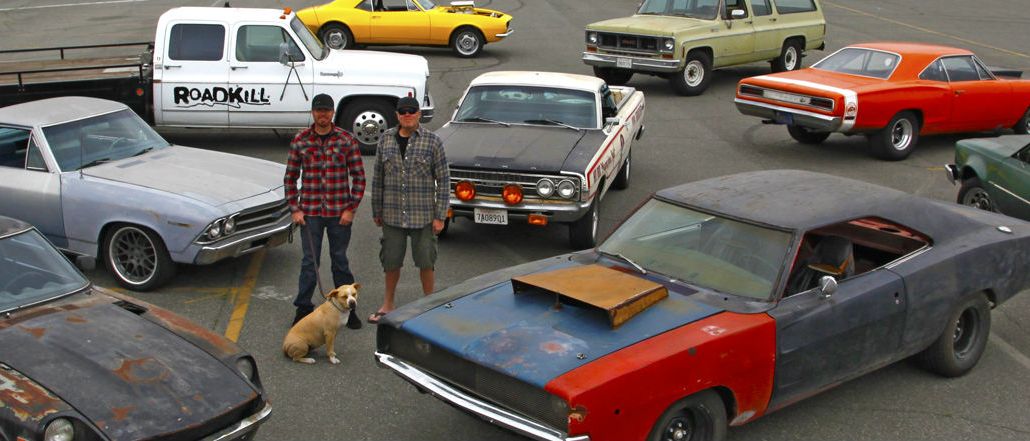Save 50% on a 3-month Digiday+ membership. Ends Dec 5.
From YouTube to print: How a video side project proved magazines aren’t roadkill

Video is the future and print is as good as dead, right? But if you’re not a fan of that idea, Roadkill is about to make your day. What started as a side project for two editors at Hot Rod magazine, a 65-year-old legacy title, has undergone a surprising evolution. Roadkill has gone from a web series to a digital property to a full-fledged print magazine on the strength of its millions-strong digital audience.
https://www.youtube.com/watch?v=fS6AXjNcTPU
Today Roadkill is a 360-degree media brand that encompasses online video, social media, web content, a print magazine and an events business, but it owes its start to Hot Rod editor-in-chief David Freiburger and staff writer Mike Finnegan. The duo had been experimenting with video in their spare time, filming themselves as they restored radically ruined cars just enough to operate, then ran them into the ground on over-the-top road trips. Then their parent company’s chief content officer, Angus MacKenzie of TEN, approached them with an offer.
“Angus actually came to us and said, ‘We like what you’re doing, and we think that we can make something from it,’” Freiburger said. MacKenzie saw potential in pairing Roadkill, the compelling name for a possible print project Freiburger had been tossing around, with the particular brand of automotive lunacy that he and Finnegan had been slinging. Freiburger, in turn, saw potential in carving out a new space, one that wasn’t beholden to a decades-long legacy. Roadkill was born.
“At Hot Rod, I had such a responsibility to the legacy of that 65-year-old brand. You can’t get too outrageous, or you annoy a certain segment of the audience,” Freiburger said. While Hot Rod and Motor Trend draw gearheads in their 40s, per TEN’s own stats, “our 18-34 share is much stronger,” he said.
Ad position: web_incontent_pos1
When Roadkill launched in 2012, the Motor Trend YouTube channel had just 150,000 subscribers and was aggressively developing new formats. Today that channel—still home to the Roadkill show, among many others—boasts more than 3.8 million subscribers and over 1.2 billion views; Roadkill episodes routinely garner more than 2 million-plus views. Even more impressive, those views don’t come from Motor Trend or Hot Rod’s core audience. Roadkill has broken new ground, according to Freiburger, tapping into a viewership from the coveted millennial cohort. Over 65% of Roadkill’s audience is in the 18 – 34 bracket.
“This younger audience . . . they don’t have preconceived notions about what’s cool and what’s not, and they don’t have any brand allegiances like the older guys have. The younger kids are interested in all the different brands and rally racing and drag racing, and there aren’t those walls, and so Roadkill covers it all,” Freiburger said.
Besides Freiburger and Finnegan, Roadkill’s staff consists of volunteers from TEN auto titles like Motor Trend and 4 Wheel & Off-Road. The opportunity to write in Roadkill’s occasionally bombastic voice appeals to its ad hoc team of auto mag vets.
That fresh voice has also attracted a new generation of car enthusiasts. “For years, they have been asking themselves, ‘Are cars going away, and how do we reach a younger consumer? And this is it,” Freiburger said. It’s also interested a handful of high profile advertisers like Dodge, sponsor of the first four issues of Roadkill, along with several branded episodes of the show.
“It’s traditional advertising at this point,” says MacKenzie, when asked if Roadkill’s print incarnation would embrace more native formats in keeping with its video origins. “We do hope to get people to have a little more fun.”
Ad position: web_incontent_pos2
While TEN is the first publisher to successfully translate a video brand to print, it’s not the only one that thinks the printed page is digital’s new frontier. Legacy publishers like Condé Nast and Meredith have turned digital-native Pitchfork and AllRecipes.com into print pubs respectively. And online retailers Net-A-Porter and ASOS have both embraced the medium as a way to extend their brand to a wider audience.
According to Angus MacKenzie, there is no magic formula for building a fully realized media business around a video brand nor is it something TEN is necessarily trying to duplicate in future video efforts. He credits Roadkill’s success to the freewheeling nature of the YouTube platform, which, he says, rewards experimentation in both form and content.
He also credits TEN’s strategy of programming for the channel: “We looked at it like a television network. We weren’t just producing short videos around content from the magazine. We were creating shows that we thought would resonate with our audience.”
In many ways, the rise of the Roadkill brand suggests a new paradigm for publishers moving deeper into the digital space. What was once a simple game of quantity is now, MacKenzie suggests, shifting toward a more complex question of audience quality. “I think a key metric going forward isn’t just going to be eyeballs,” he says. “It’s going to be eyeballs plus engagement. It’s the multiplier that makes audiences matter, and that kind of engagement can only come from video.”
More from Digiday

What publishers are wishing for this holiday season: End AI scraping and determine AI-powered audience value
Publishers want a fair, structured, regulated AI environment and they also want to define what the next decade of audience metrics looks like.

Ulta, Best Buy and Adidas dominate AI holiday shopping mentions
The brands that are seeing the biggest boost from this shift in consumer behavior are some of the biggest retailers.

Digiday+ Research Subscription Index 2025: Subscription strategies from Bloomberg, The New York Times, Vox and others
Digiday’s third annual Subscription Index examines and measures publishers’ subscription strategies to identify common approaches and key tactics among Bloomberg, The New York Times, Vox and others.
Ad position: web_bfu


